2016 CHEVROLET EXPRESS CARGO VAN ignition
[x] Cancel search: ignitionPage 4 of 30

Chevrolet/GMC Express/Savana CNG Compressed Natural Gas Supplement
(GMNA-Localizing-U.S/Canada-9159237) - 2016 - crc - 6/18/15
Instruments and Controls 3
Instruments and
Controls
Warning Lights, Gauges, and
Indicators
Fuel Gauge . . . . . . . . . . . . . . . . . . . . . 3
Malfunction Indicator Lamp(Check Engine Light) . . . . . . . . . . 3
Warning Lights,
Gauges, and
Indicators
Fuel Gauge
When the ignition is on, the fuel
gauge indicates about how much
fuel is left in the vehicle fuel tank.
An arrow on the fuel gauge
indicates the side of the vehicle the
fuel door is on. The fuel gauge has been calibrated
to display full at approximately
24 800 kPa (3,600 psig) and empty
at approximately 2 758 kPa
(400 psig).
When the low fuel warning indicator
flashes, fill the tank as soon as
possible.
Compressed Natural Gas (CNG)
fuel gauge readings are affected by
changes in fuel temperature and
fuel pressure.
See
Filling the Tank 07.
Malfunction Indicator
Lamp (Check Engine
Light)
Page 5 of 30

Chevrolet/GMC Express/Savana CNG Compressed Natural Gas Supplement
(GMNA-Localizing-U.S/Canada-9159237) - 2016 - crc - 6/18/15
4 Instruments and Controls
This vehicle has been specifically
designed to illuminate this indicator
when emissions exceed acceptable
levels while operating on natural
gas fuel.
The malfunction indicator lamp
comes on to indicate that there is a
problem and service is required.
Malfunctions often will be indicated
by the system before any problem is
apparent. This system is also
designed to assist the service
technician in correctly diagnosing
any malfunction.
Caution
If the vehicle is continually driven
with this light on, the emission
controls might not work as well,
the vehicle fuel economy might
not be as good, and the engine
might not run as smoothly. This
could lead to costly repairs that
might not be covered by the
vehicle warranty.This light should come on, as a
check to show you it is working,
when the ignition is on and the
engine is not running.
See the owner manual for more
information.
Page 7 of 30
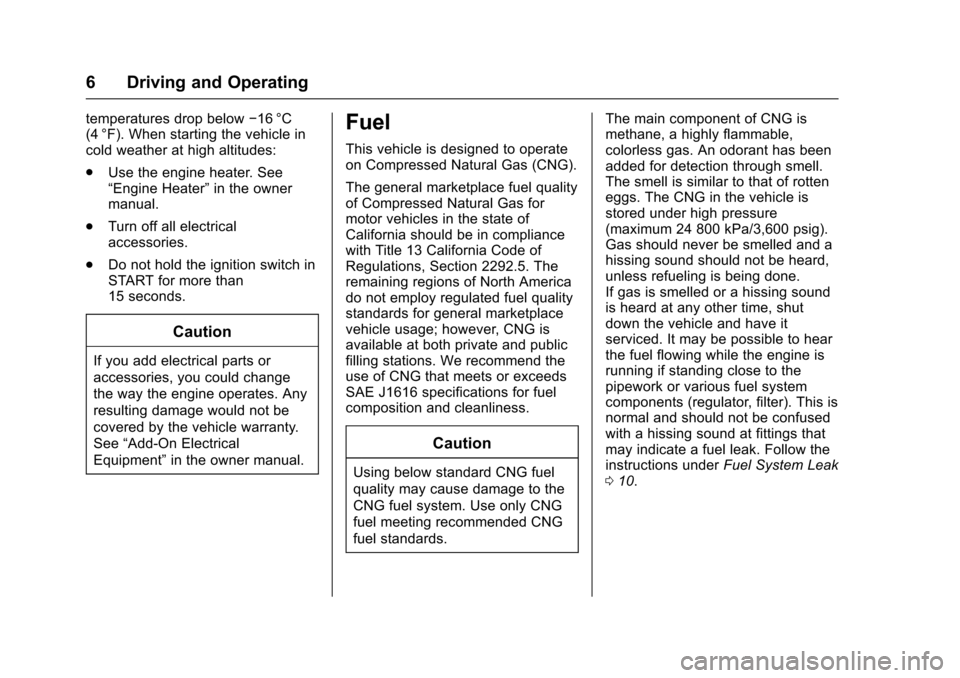
Chevrolet/GMC Express/Savana CNG Compressed Natural Gas Supplement
(GMNA-Localizing-U.S/Canada-9159237) - 2016 - crc - 6/18/15
6 Driving and Operating
temperatures drop below−16 °C
(4 °F). When starting the vehicle in
cold weather at high altitudes:
. Use the engine heater. See
“Engine Heater” in the owner
manual.
. Turn off all electrical
accessories.
. Do not hold the ignition switch in
START for more than
15 seconds.
Caution
If you add electrical parts or
accessories, you could change
the way the engine operates. Any
resulting damage would not be
covered by the vehicle warranty.
See “Add-On Electrical
Equipment” in the owner manual.
Fuel
This vehicle is designed to operate
on Compressed Natural Gas (CNG).
The general marketplace fuel quality
of Compressed Natural Gas for
motor vehicles in the state of
California should be in compliance
with Title 13 California Code of
Regulations, Section 2292.5. The
remaining regions of North America
do not employ regulated fuel quality
standards for general marketplace
vehicle usage; however, CNG is
available at both private and public
filling stations. We recommend the
use of CNG that meets or exceeds
SAE J1616 specifications for fuel
composition and cleanliness.
Caution
Using below standard CNG fuel
quality may cause damage to the
CNG fuel system. Use only CNG
fuel meeting recommended CNG
fuel standards. The main component of CNG is
methane, a highly flammable,
colorless gas. An odorant has been
added for detection through smell.
The smell is similar to that of rotten
eggs. The CNG in the vehicle is
stored under high pressure
(maximum 24 800 kPa/3,600 psig).
Gas should never be smelled and a
hissing sound should not be heard,
unless refueling is being done.
If gas is smelled or a hissing sound
is heard at any other time, shut
down the vehicle and have it
serviced. It may be possible to hear
the fuel flowing while the engine is
running if standing close to the
pipework or various fuel system
components (regulator, filter). This is
normal and should not be confused
with a hissing sound at fittings that
may indicate a fuel leak. Follow the
instructions under
Fuel System Leak
0 10.
Page 9 of 30
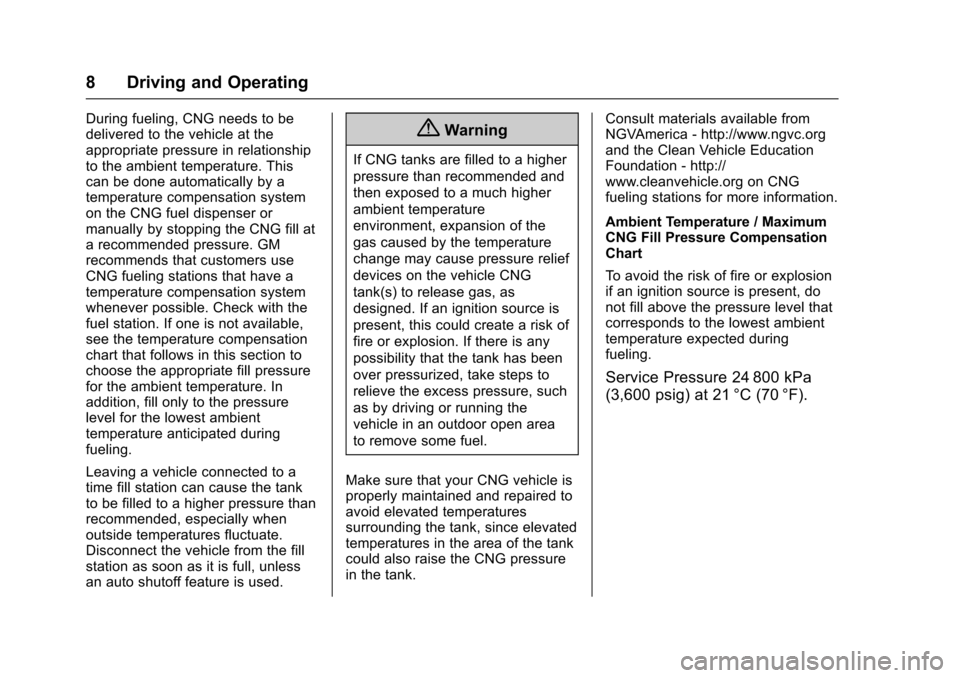
Chevrolet/GMC Express/Savana CNG Compressed Natural Gas Supplement
(GMNA-Localizing-U.S/Canada-9159237) - 2016 - crc - 6/18/15
8 Driving and Operating
During fueling, CNG needs to be
delivered to the vehicle at the
appropriate pressure in relationship
to the ambient temperature. This
can be done automatically by a
temperature compensation system
on the CNG fuel dispenser or
manually by stopping the CNG fill at
a recommended pressure. GM
recommends that customers use
CNG fueling stations that have a
temperature compensation system
whenever possible. Check with the
fuel station. If one is not available,
see the temperature compensation
chart that follows in this section to
choose the appropriate fill pressure
for the ambient temperature. In
addition, fill only to the pressure
level for the lowest ambient
temperature anticipated during
fueling.
Leaving a vehicle connected to a
time fill station can cause the tank
to be filled to a higher pressure than
recommended, especially when
outside temperatures fluctuate.
Disconnect the vehicle from the fill
station as soon as it is full, unless
an auto shutoff feature is used.{Warning
If CNG tanks are filled to a higher
pressure than recommended and
then exposed to a much higher
ambient temperature
environment, expansion of the
gas caused by the temperature
change may cause pressure relief
devices on the vehicle CNG
tank(s) to release gas, as
designed. If an ignition source is
present, this could create a risk of
fire or explosion. If there is any
possibility that the tank has been
over pressurized, take steps to
relieve the excess pressure, such
as by driving or running the
vehicle in an outdoor open area
to remove some fuel.
Make sure that your CNG vehicle is
properly maintained and repaired to
avoid elevated temperatures
surrounding the tank, since elevated
temperatures in the area of the tank
could also raise the CNG pressure
in the tank. Consult materials available from
NGVAmerica - http://www.ngvc.org
and the Clean Vehicle Education
Foundation - http://
www.cleanvehicle.org on CNG
fueling stations for more information.
Ambient Temperature / Maximum
CNG Fill Pressure Compensation
Chart
To avoid the risk of fire or explosion
if an ignition source is present, do
not fill above the pressure level that
corresponds to the lowest ambient
temperature expected during
fueling.
Service Pressure 24 800 kPa
(3,600 psig) at 21 °C (70 °F).
Page 12 of 30
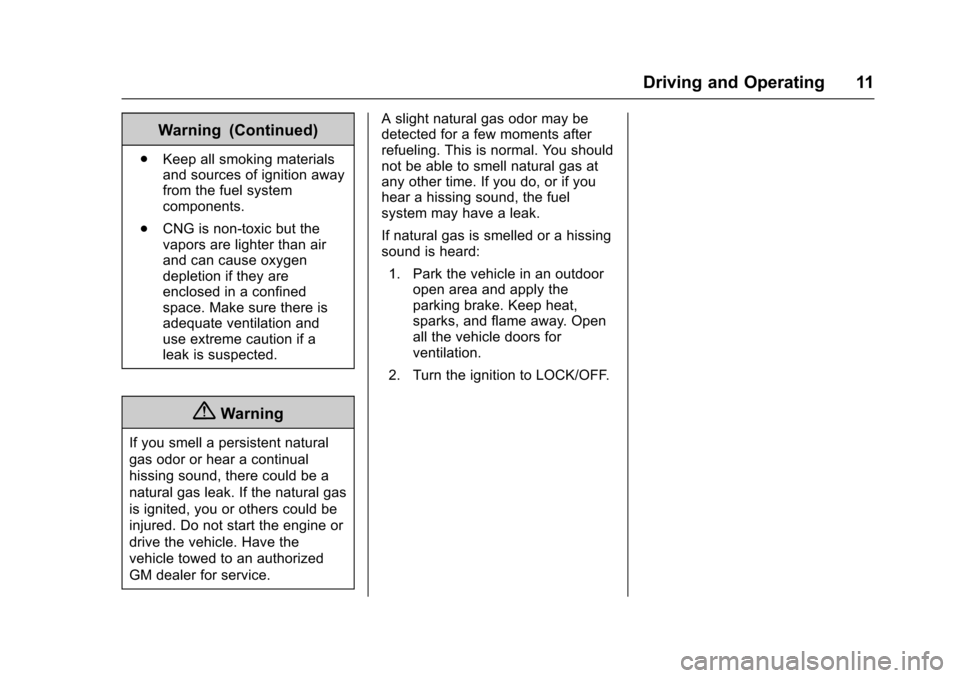
Chevrolet/GMC Express/Savana CNG Compressed Natural Gas Supplement
(GMNA-Localizing-U.S/Canada-9159237) - 2016 - crc - 6/18/15
Driving and Operating 11
Warning (Continued)
.Keep all smoking materials
and sources of ignition away
from the fuel system
components.
. CNG is non-toxic but the
vapors are lighter than air
and can cause oxygen
depletion if they are
enclosed in a confined
space. Make sure there is
adequate ventilation and
use extreme caution if a
leak is suspected.
{Warning
If you smell a persistent natural
gas odor or hear a continual
hissing sound, there could be a
natural gas leak. If the natural gas
is ignited, you or others could be
injured. Do not start the engine or
drive the vehicle. Have the
vehicle towed to an authorized
GM dealer for service. A slight natural gas odor may be
detected for a few moments after
refueling. This is normal. You should
not be able to smell natural gas at
any other time. If you do, or if you
hear a hissing sound, the fuel
system may have a leak.
If natural gas is smelled or a hissing
sound is heard:
1. Park the vehicle in an outdoor open area and apply the
parking brake. Keep heat,
sparks, and flame away. Open
all the vehicle doors for
ventilation.
2. Turn the ignition to LOCK/OFF.
Page 17 of 30
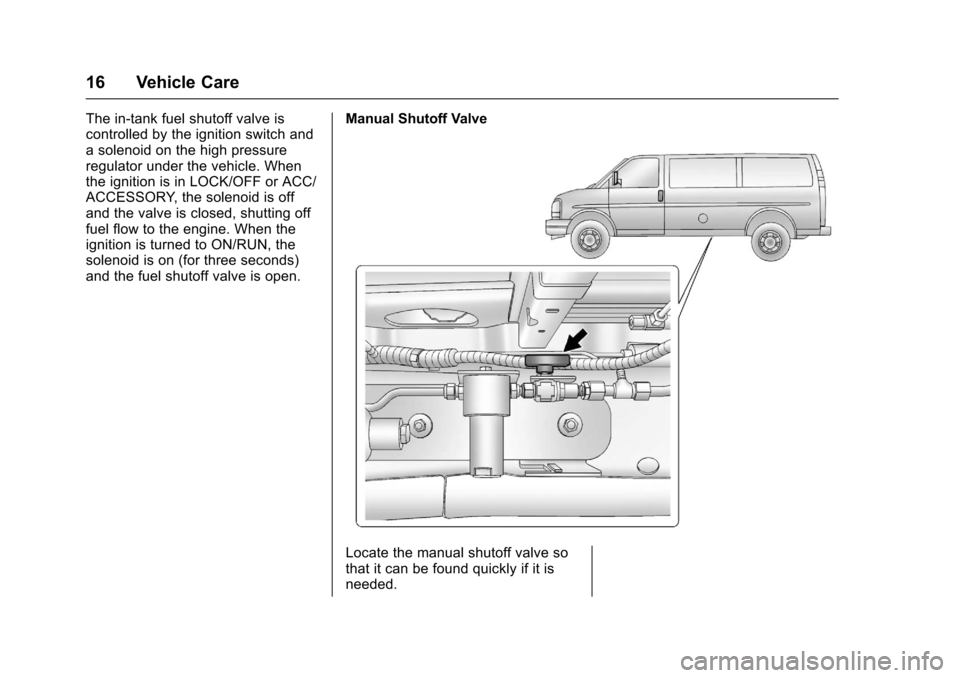
Chevrolet/GMC Express/Savana CNG Compressed Natural Gas Supplement
(GMNA-Localizing-U.S/Canada-9159237) - 2016 - crc - 6/18/15
16 Vehicle Care
The in-tank fuel shutoff valve is
controlled by the ignition switch and
a solenoid on the high pressure
regulator under the vehicle. When
the ignition is in LOCK/OFF or ACC/
ACCESSORY, the solenoid is off
and the valve is closed, shutting off
fuel flow to the engine. When the
ignition is turned to ON/RUN, the
solenoid is on (for three seconds)
and the fuel shutoff valve is open.Manual Shutoff Valve
Locate the manual shutoff valve so
that it can be found quickly if it is
needed.
Page 19 of 30
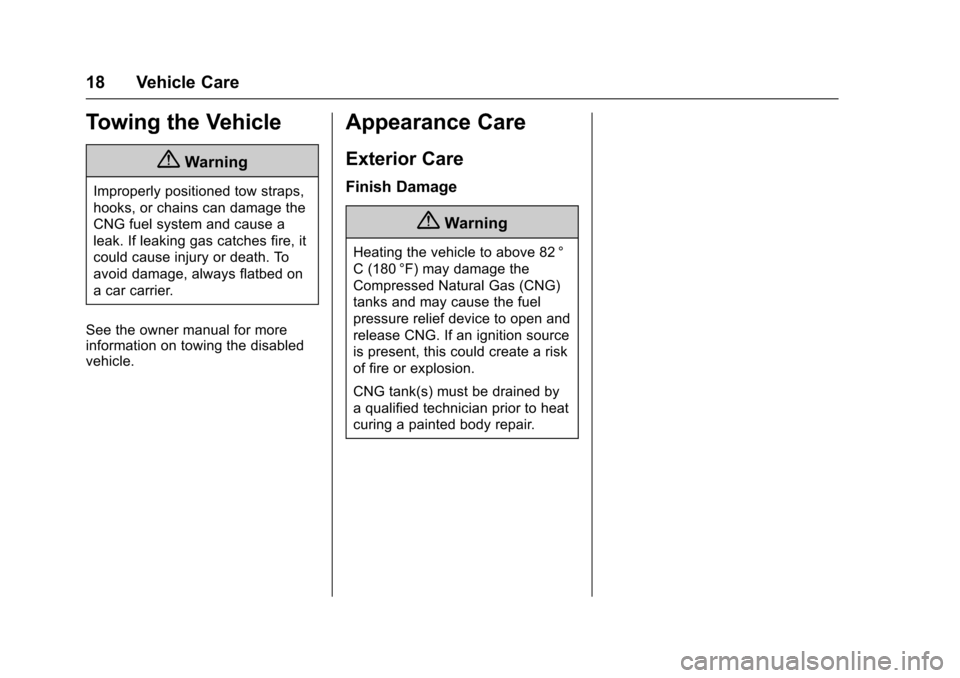
Chevrolet/GMC Express/Savana CNG Compressed Natural Gas Supplement
(GMNA-Localizing-U.S/Canada-9159237) - 2016 - crc - 6/18/15
18 Vehicle Care
Towing the Vehicle
{Warning
Improperly positioned tow straps,
hooks, or chains can damage the
CNG fuel system and cause a
leak. If leaking gas catches fire, it
could cause injury or death. To
avoid damage, always flatbed on
a car carrier.
See the owner manual for more
information on towing the disabled
vehicle.
Appearance Care
Exterior Care
Finish Damage
{Warning
Heating the vehicle to above 82 °
C (180 °F) may damage the
Compressed Natural Gas (CNG)
tanks and may cause the fuel
pressure relief device to open and
release CNG. If an ignition source
is present, this could create a risk
of fire or explosion.
CNG tank(s) must be drained by
a qualified technician prior to heat
curing a painted body repair.